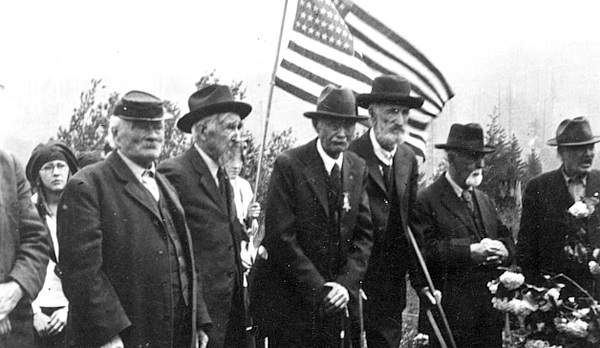Autumn sun warns the young sycamore in its new surroundings, a ring of boulders.
The 15-foot tree will someday grow into a giant, a Legacy Tree overshadowing the stones that now sit at the Snoqualmie Valley Veteran’s Memorial.
On this October day, the memorial project is still a work in progress. Gravel, bare earth, electrical conduit and concrete foundations await the finished monument stone and flags, but organizers say everything should be in place by Veteran’s Day, 11-11-11.
The opening of the new veterans monument remains on track, committee president Chris Chartier said. Congressman Dave Reichert, Washington’s ‘First Husband’ Mike Gregoire, State Rep. Jay Rodne and Snoqualmie Mayor Matt Larson have been invited to speak at the dedication at 11:11 a.m. on Veteran’s Day. Members of the Snoqualmie Tribe will also bless the occasion.
“The whole purpose of the memorial is hoto nor all our vets,” Chartier said, “specifically those who were killed in the line of duty. It’s important to have one place that we can go to visit and honor our veterans.”
Ground was broken on Veteran’s Day, 2008, on land next to the Snoqualmie American Legion Post, donated by the city of Snoqualmie, directly across from City Hall. Committee members considered places like Tollgate Farm, Meadowbrook Farm and the Fall City roundabout, but chose the Snoqualmie site for its easy access, association with veteran’s groups and purchase price—free.
Plans call for a central stone monument surrounded by seven flag poles, benches and a brick plaza. Stone columns under the poles will display the emblems of military branches.
Part of the stone will be carved with a tribal symbol reflecting Snoqualmie Tribal members’ sacrifices for the larger nation.
In 1855, Snoqualmie warriors fought on the side of Washington territory’s white settlers.
“There were losses,” committee member Dave Battey said. “Nobody knows who they were. But we still want to honor them.”
The central stone will terminate in a three-dimensional carving of Mount Si. That helps viewers find “their” Mount Si, Battey said.
Old monuments, wooden reminders
The new memorial under construction is only the latest in a long line of temporary and permanent reminders of local military service and sacrifice.
According to Cristy Lake of the Snoqualmie Valley Historical Museum, the first local memorial went up in 1908, when the Great White Fleet, the United States’ white-painted global naval expedition, came to Seattle. Citizens of Fall City built a commemorative arch when several of the fleet’s naval commanders visited Snoqualmie Falls.
After World War I, Preston residents planted four trees in honor of the young Preston men killed in the war.
Fall City started its own veteran’s memorial at the local cemetery some time after World War I. That memorial, which did not have any names, lasted until World War II. The historical society has found photos of local American Legion members holding Memorial Day commemorations.
During World War II, citizens of North Bend, Fall City and Snoqualmie Falls each built wooden memorials in honor of their soldiers. All three structures were torn down by the early 1950s.
At the Snoqualmie Falls mill, a wooden monument to employees in the service overlooked the grounds. Built of wooden slats marked with the names of everyone at the mill who was drafted or volunteered in World War II, the monument showed the surprising amount of patriotism and service from such a small community. A photo from that era shows 102 employees’ names emplaced on the sign.
One of Dave Battey’s uncles, George Swenson, was remembered on it. George had enlisted and was in training when the war ended.
Another, more ephemeral local remembrance came in the Snoqualmie Falls Lumber Company newsletter. When mill workers began to enter the service, their names were published in the newsletter, which became an important connection between soldiers and the folks back home.
In North Bend, a wooden monument stood in front of the Lee Brothers store, the main grocery store in town—and the logical place for a memorial, Battey said. The names were in the front and center, and a U.S. flag waved above.
Historians with the Snoqualmie Valley museum would like the community’s help in pinning down exactly when these monuments went away.
After the war, Carnation built a stone and bronze memorial for Tolt’s fallen soldiers. Someone also erected a flagpole in the Mount Si Cemetery in North Bend.
The Mount Si High School class of 1966 built a memorial for their classmates killed in action. However, this did not include other students killed in the line of duty. Recently, Eric Levi Ward, a Marine Lance Cpl. who was killed in February 2010 during the Afghanistan conflict, was added to that memorial
There has never been a memorial erected for Korean War veterans. The new monument under construction in Snoqualmie is meant to rectify that, and will include all 70 men, and one woman, from the Valley who were killed in the line of duty in all wars, from the Spanish-American War to the present.
Today’s needs
The veteran’s memorial committee is still selling memorial bricks, as a fundraiser for the project and as a way to flesh out the paved plaza.
Bricks can be inscribed with the name of any loved one who served their country, regardless of whether the Valley was their home. Bricks cost $100.
To order a memorial brick or get involved, contact Chris Chartier at (425) 888-9152 or by cell at (425) 802-5174.



